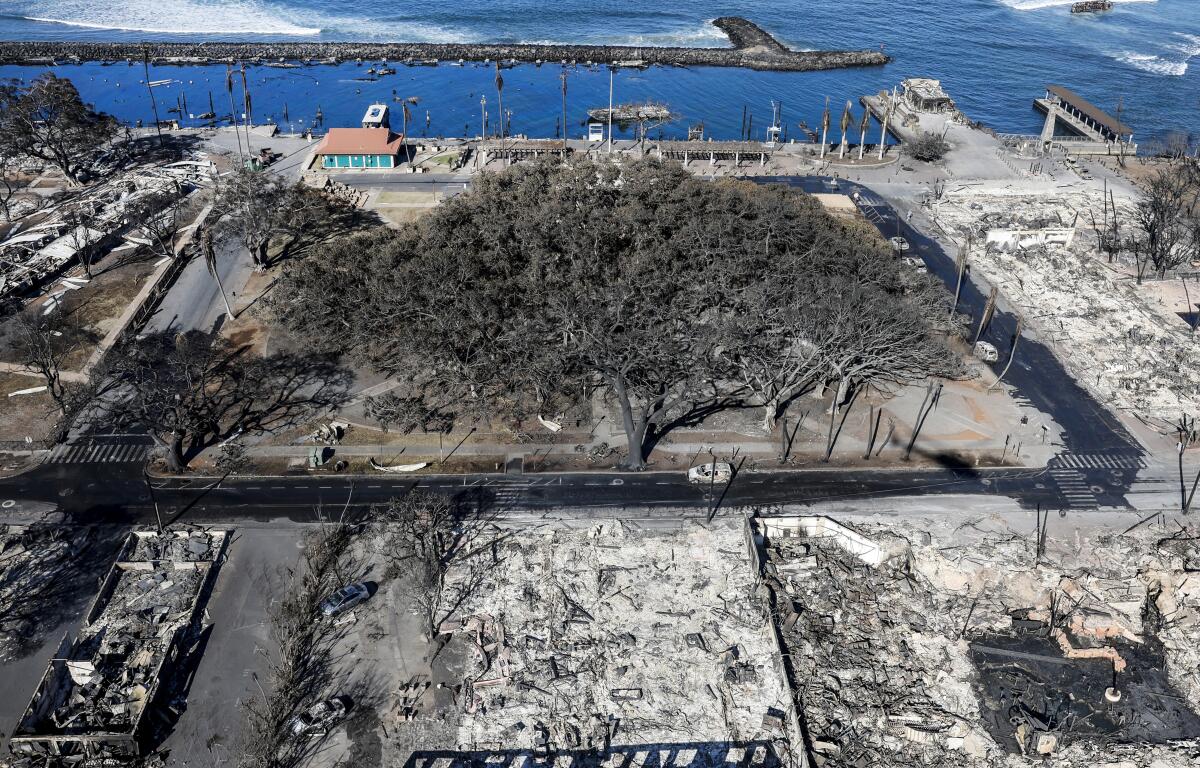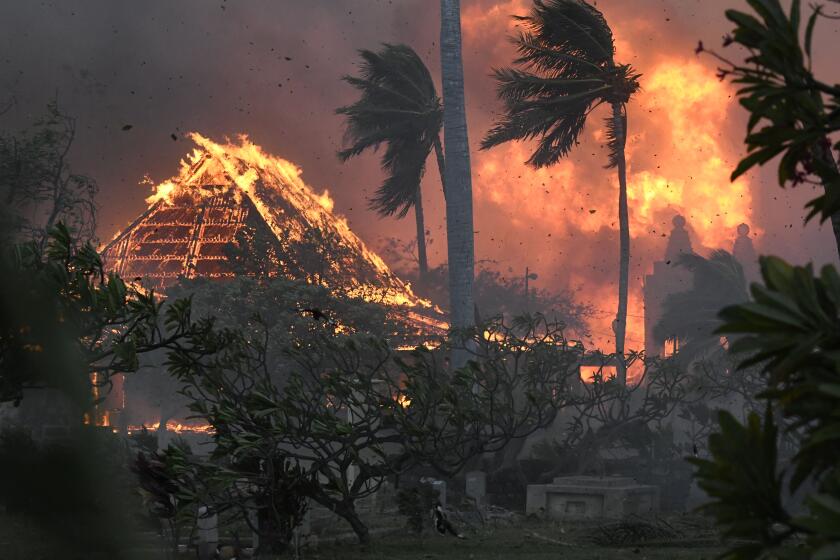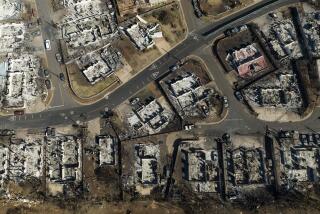Mourning the catastrophic loss of Hawaiian culture and history in Lahaina

- Share via
As it so often is, Lahaina’s Front Street was set on Saturday to be a scene celebrating the Hawaiian culture that is so deeply rooted on the storied strip of shoreline.
Hundreds were expected to flood the historic street on Maui for the town’s annual hula festival, a commemoration of a renowned hula performer, the late Emma Farden Sharpe, whose ancestral home was where the corner of Front and Shaw streets now sit.
Now it is the site of one of the worst disasters in Hawaiian history. The wildfire that killed at least 80 people this week leveled much of the National Historical Landmark District, razing the town’s cultural treasures.
Like no other place in the archipelago, old Lahaina connected the modern era of tourism to Hawaii’s deeper, more textured past — both independent and colonial — an old wooden seaport that was once capital of a kingdom, next to its modern twin, Kaanapali, one of the state’s biggest hotel and condo destinations.
The old courthouse, which usually serves as a backdrop for the hula festival, was gutted. The Baldwin House, nearly two centuries old and home of the first missionaries to the island, was flattened, as was the 122-year-old Pioneer Inn, whose guests included Mark Twain, Jack London and the Hawaii’s last queen, Liliuokalani.
Locals and tourists alike are praying for the iconic banyan tree, which formed its own little jungle canopy with multiple trunks — a quarter mile in circumference. Images show the tree blackened, but it’s unclear if the roots will survive.
Hailama Farden, Sharpe’s great-nephew and former president of the Hawaiian Historical Society, said the waterfront blocks where the celebration of life was meant to take place are now a scene of total destruction.
“I’m mourning,” said Farden, who was supposed to fly in Friday to emcee the festival. “Generations of people sat under that tree. My great-grandparents were there. My grandparents played under the tree. We played under that tree. It’s generations.”
As the fires on Maui have demonstrated, Hawai’i doesn’t offer an escape from the problems elsewhere.
While the death toll keeps mounting, those with deep ties to Lahaina say they’re just beginning to grapple with the historic gems they have lost.
Nowhere in the island chain was history so well preserved — and nowhere is the immense cultural loss now more apparent — than the Front Street area.
Kalei Nuʻuhiwa, who grew up in Lahaina, said she would always take visitors to the street to point out the landmarks: the banyan tree — planted a century and a half ago to commemorate the area’s first Protestant mission. The harbor, whose calm, deep waters made it a destination for the American whaling fleets in the 19th century. The old courthouse, which long ago served as a custom house for trade ships.
“We just use that street as a touching point on how we came to be and who we are,” Nuʻuhiwa said. “It’s devastating that that’s no longer there.”
Lahaina is far more than a tourist hub.
After unifying the Hawaiian islands into one kingdom at the start of the 19th century, King Kamehameha established his royal residence in Lahaina. The coastal town would become the capital of the kingdom from 1820 to 1845, according to the National Park Service.
“It became a center of political power,” said Davianna McGregor, a retired professor of ethnic studies at the University of Hawaii, Manoa.
In the early 1800s, fleets of American whaling ships began to make port in Lahaina, reshaping the economy as sailors flooded the town. At the height of the whaling industry in the 1850s, more than 400 whaling ships docked in Lahaina each year. At the same time, missionaries from New England arrived to convert the Hawaiians to Christianity (and often clashed with drunken whalers). They founded the Wainee Church next to a pond in 1823 and locals have worshiped there ever since.
The Hawaiian Islands do see wildfire from time to time, but the catastrophic Maui fires were spawned by a striking mix of factors, including climate change.
The most recent chapel, rebuilt after a fire in 1894 and renamed Waiola, burned to the ground this week. Its cemetery holds the remains of many of Hawaii’s kings, queens, high chiefs and princesses.
When the whaling industry collapsed, a new industry of sugar production began to take hold. Pioneer Mill, one of Hawaii’s first sugar mills, opened in 1860, helping make sugar cane a fixture of the West Maui economy.
Thousands of Chinese immigrants came to Maui during this time to work on the plantations, according to the Lahaina Restoration Foundation, a nonprofit that maintains a number of historic structures in Lahaina, including the Old Lahaina Prison, the Plantation Museum and the Wo Hing Museum. In the early 1900s, they formed the Wo Hing Society and later built the historic two-story temple that served as a gathering place for the island’s expat community.
Lahaina Restoration Foundation Director Theo Morrison told ABC News the wooden Wo Hing temple is “completely gone.” Satellite images show most of the buildings in the historic district completely destroyed.
“These are structures that can’t be replaced,” she said.
The town’s heritage was infused in the old buildings, which looked like they came from an old cowboy movie: wooden, creaky, and extremely flammable.
“It was all boarded buildings, wooden buildings, storefronts, but all very close together. Maybe just an alleyway between them,” McGregor said. “So of course, it just went up like a matchbox.”
The long history of Lahaina is not just a story of changing industry but also one of extreme resilience from Native Hawaiians, said Kamanamaikalani Beamer, a professor at the University of Hawaii at Manoa‘s Center for Hawaiian Studies.
The same communities hit hardest by these fires are the ones that fiercely battled the diversions of water to sugar and pineapple plantations, which dried out their land, and the downside of a booming tourism industry, which left them priced out of their own homes.
“They’re such a strong, resilient community,” Beamer said. “If there is a community that’s an example of resilience and battling these structures for so many generations … I think it’s them.”
More to Read
Sign up for Essential California
The most important California stories and recommendations in your inbox every morning.
You may occasionally receive promotional content from the Los Angeles Times.












